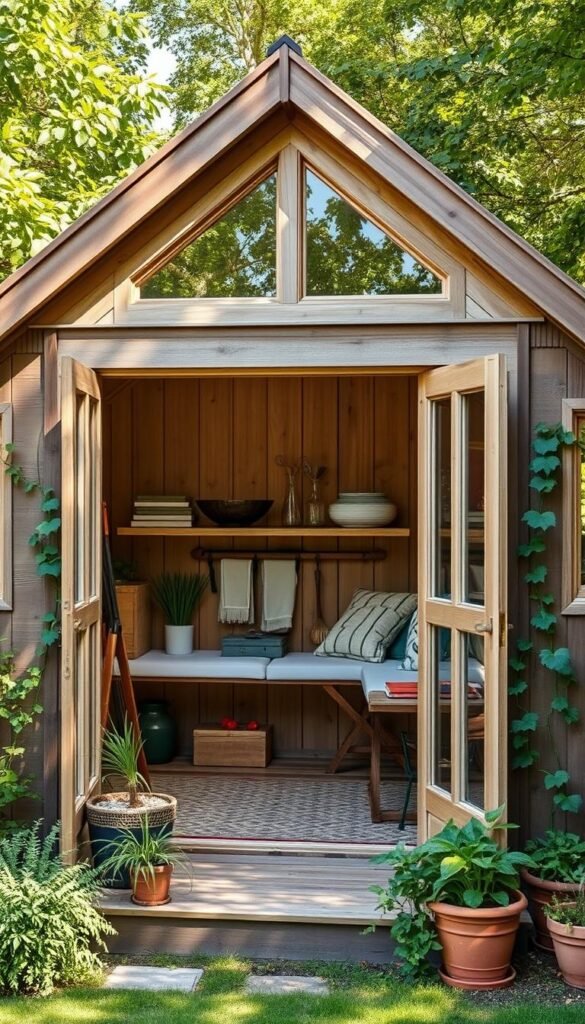Imagine transforming your outdoor area into a functional yet beautiful retreat. Modern structures once used solely for keeping tools now serve as extensions of your home’s personality. Overholt & Sons analyzed thousands of designs to curate 30 remarkable examples that blend practicality with artistic vision.
Today’s versatile structures go beyond basic organization. They create visual interest while solving clutter challenges. Whether you prefer a cozy cottage aesthetic or sleek industrial lines, these spaces prove storage can be both useful and eye-catching.
Choosing the right design requires balancing your needs with your landscape’s character. Consider how materials like cedar or metal age over time, and how colors interact with seasonal foliage. A well-planned structure becomes a natural extension of your property rather than an afterthought.
From hobby studios to compact workshops, these multi-functional spaces add value to your lifestyle. They protect equipment from weather while offering room for creativity. With smart planning, your backyard’s new centerpiece might just become your favorite spot to unwind.
Exploring the Charm of Aged and Rustic Sheds
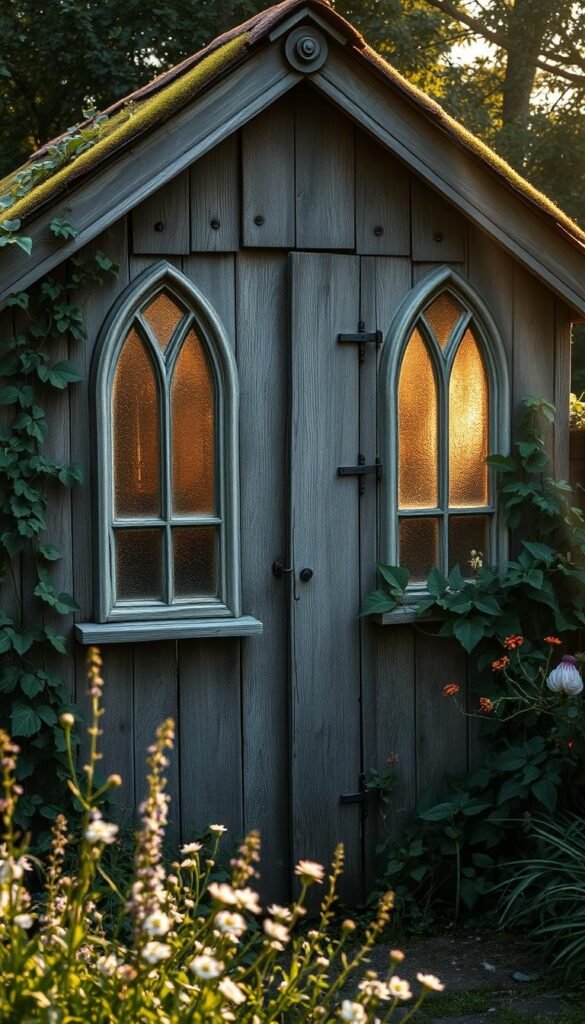
There’s magic in structures that wear their history proudly. An aged shed with peeling paint and a rusted roof isn’t just storage – it’s a living scrapbook of your landscape’s journey. These time-worn treasures blend seamlessly with nature, their imperfections creating texture that new builds can’t replicate.
Embracing Weathered Beauty and Time-Honored Details
Those flaking paint layers? They’re nature’s own patina. Instead of fighting decay, enhance it with clear sealants that protect while preserving character. Salvaged materials like barn wood add instant history, especially when paired with modern touches like energy-efficient lighting.
Gothic-style windows elevate ordinary structures into storybook features. Their pointed arches catch sunlight differently throughout the day, casting ever-changing shadows across your rustic garden. For authentic charm, try repurposing vintage architectural elements from salvage yards.
Gothic Windows and Rustic Roof Inspirations
A weathered metal roof does double duty – it weathers beautifully and lasts decades. Pair it with cedar shakes for contrast, letting materials silver naturally over time. This approach reduces maintenance while creating visual harmony with mature plantings.
Remember: true rustic style celebrates flaws. That mossy corner? It’s a habitat for beneficial insects. Those nail holes? They’re proof of decades of service. By preserving existing structures, you’re not just saving money – you’re honoring your land’s unique narrative.
Transforming Out-of-Date Structures into Potting Sheds
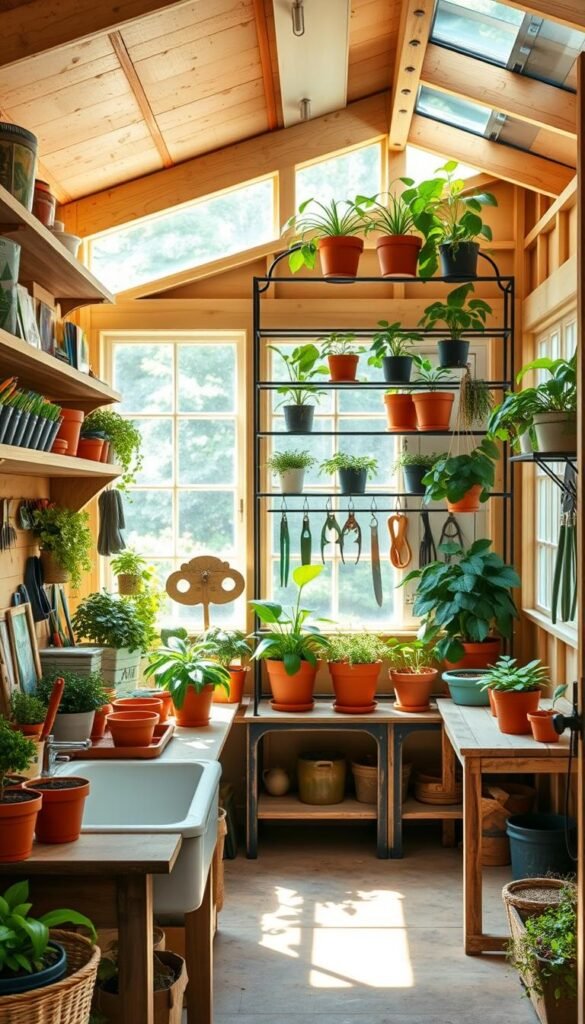
Your unused shed could become the heart of your gardening projects. Even a cramped corner offers enough space for potting plants or storing tools. With clever adjustments, these forgotten areas evolve into efficient work zones that blend function with personality.
Innovative Ways to Repurpose an Old Structure
Start by installing fold-down work surfaces that disappear when not in use. Vertical storage solutions – like pegboards or hanging baskets – keep soil bags and trowels within reach without cluttering floors. A repurposed kitchen cart makes a mobile station for seedlings and watering cans.
Prioritize three essentials: drainage grooves on counters, LED task lighting, and a nearby water source. These upgrades prevent messes and eye strain during delicate transplant work. For supplies, try stacking wooden crates or mounting magnetic strips for metal tools.
Don’t overlook airflow. Add adjustable vents or a small fan to combat humidity. Weatherstripping around windows protects seeds from temperature swings. If your budget’s tight, paint the interior white to brighten the space and use vintage jars for organizing packets.
The best part? Your new potting shed can double as a planning station. Hang a chalkboard for sketching layouts or track plant growth on a wall calendar. Suddenly, that outdated structure becomes where dreams for next season’s blooms take root.
Creative Nook Transformations for Personal Spaces
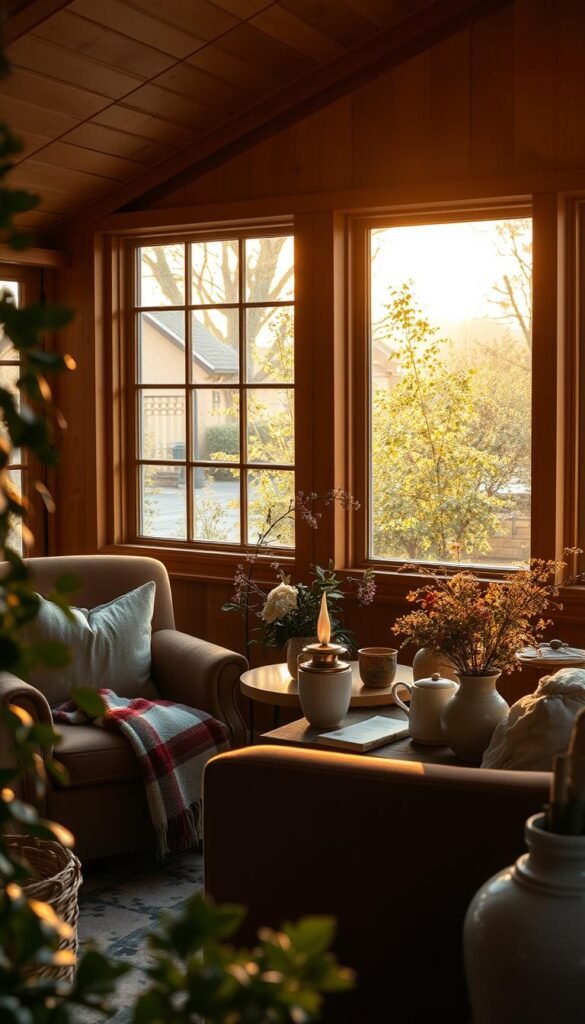
Your backyard holds hidden potential beyond tool storage. With imagination, ordinary structures become sanctuaries where creativity blooms and stress fades. Let’s explore how to reimagine these corners into retreats that spark joy.
Crafting Your Private Sanctuary
Start by defining your space’s purpose. Will it host morning yoga sessions or late-night reading marathons? Choose furniture that serves dual roles – think window seats with hidden compartments or fold-out desks. Soft textiles like outdoor rugs and weather-resistant cushions add comfort without sacrificing durability.
Lighting sets the mood. String lights create fairy-tale charm, while adjustable LED lamps offer task illumination. For storage, use vertical wall planters as book holders or hang floating shelves for decor. A fresh coat of paint in calming blues or energizing yellows instantly personalizes your retreat.
Climate control matters year-round. Insulate walls with foam boards and seal gaps around windows. Portable heaters or mini-split systems maintain comfort during temperature extremes. Always consult an electrician when installing outlets for safety.
Divide your garden shed into functional zones using room dividers or area rugs. A corner desk becomes a writing nook, while floor pillows transform another section into a meditation spot. The key? Let your personality shine through curated art, family photos, or collections that tell your story.
These ideas prove even compact areas can become cherished escapes. Your reinvented backyard haven awaits – a place where every detail reflects what makes you feel most at peace.
Designing with Reclaimed Materials and Natural Elements
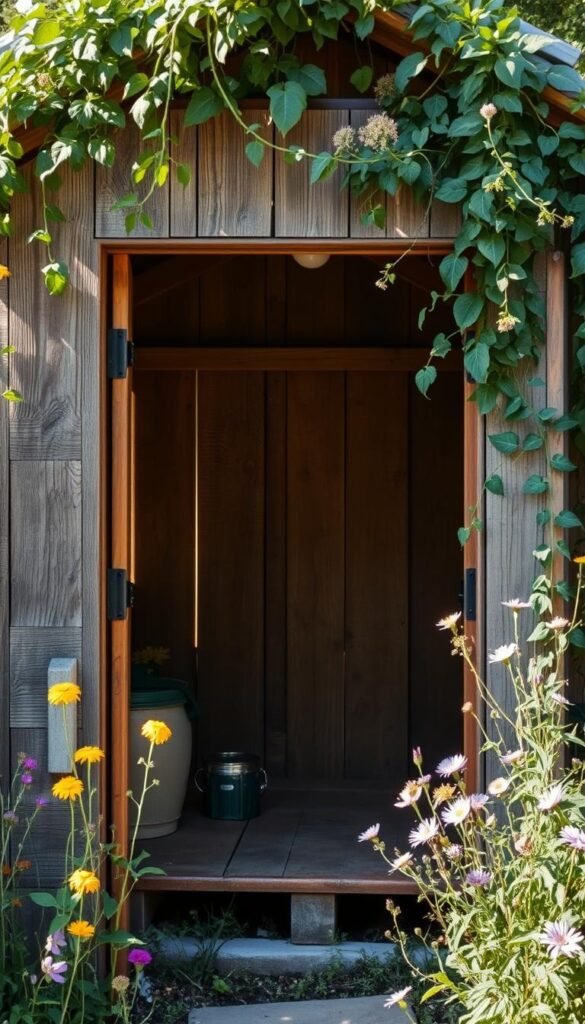
Breathing new life into forgotten materials creates structures rich with character. Salvaged wood and retired architectural pieces tell stories through their knots, cracks, and weathered surfaces. These elements bring authenticity to your space while keeping costs low – a win for both your wallet and the environment.
Utilizing Driftwood, Pallets, and Reused Wood
Scout local demolition sites or online marketplaces for quality finds. Old windows make perfect wall panels, letting light flood in without the price tag of new glass. Pallets dismantle into sturdy wall planks – just sand them smooth and seal with outdoor-grade polyurethane.
Driftwood’s organic shapes become striking door handles or decorative trim. For structural elements like rafters, test each piece’s strength by pressing firmly – if it bends or cracks, save it for non-weight-bearing accents. Always clean materials thoroughly with a bleach solution to remove pests or mold.
Mix textures thoughtfully. Pair rough-sawn barn wood with sleek polycarbonate roofing for modern-rustic contrast. As one builder notes: “Those nail holes and saw marks aren’t flaws – they’re proof your materials lived full lives before meeting your vision.”
Safety first! Test older paint for lead using kits from hardware stores. Reinforce joints with metal brackets when using weathered wood for load-bearing walls. For budget-friendly projects, consider combining reclaimed elements with new foundations to ensure stability.
Your finished creation becomes more than storage – it’s a testament to resourcefulness. Every salvaged hinge and sun-bleached plank adds depth that mass-produced materials can’t match.
Incorporating Bold Architectural Features
Architectural drama isn’t just for homes—your shed can make a powerful statement too. Steeply pitched roofs transform ordinary structures into eye-catching landmarks, marrying bold aesthetics with smart functionality. These designs don’t just elevate your space visually—they solve practical challenges like weather resistance and vertical storage.
Showcasing Steep Roofs and Sharp Lines for Unique Style
A 45-degree slope does more than shrug off rain—it creates airy headroom inside. This extra height lets you add overhead racks for seasonal items or even a loft for tools. Metal roofing shines here, its angular surfaces catching sunlight like folded origami.
Geometric shapes bring modern flair to traditional layouts. Pair triangular windows with trapezoidal planter boxes for cohesive design. “Dramatic angles guide the eye upward, making compact buildings feel grand,” notes a Colorado-based builder. This trick works wonders in small yards where every inch counts.
Balance is key. Match your roof pitch to your home’s existing lines—a barn-style gable complements farmhouses, while flat-fronted peaks suit mid-century layouts. Check local codes for snow load requirements and wind resistance specs before finalizing plans.
Material choices amplify the look. Dark-stained cedar contrasts beautifully with matte black trim. For low-maintenance options, consider synthetic slate tiles that mimic natural textures without the weight. These details turn functional spaces into conversation-starting features that redefine your outdoor area’s personality.
Blending the Past with Modern Design Trends
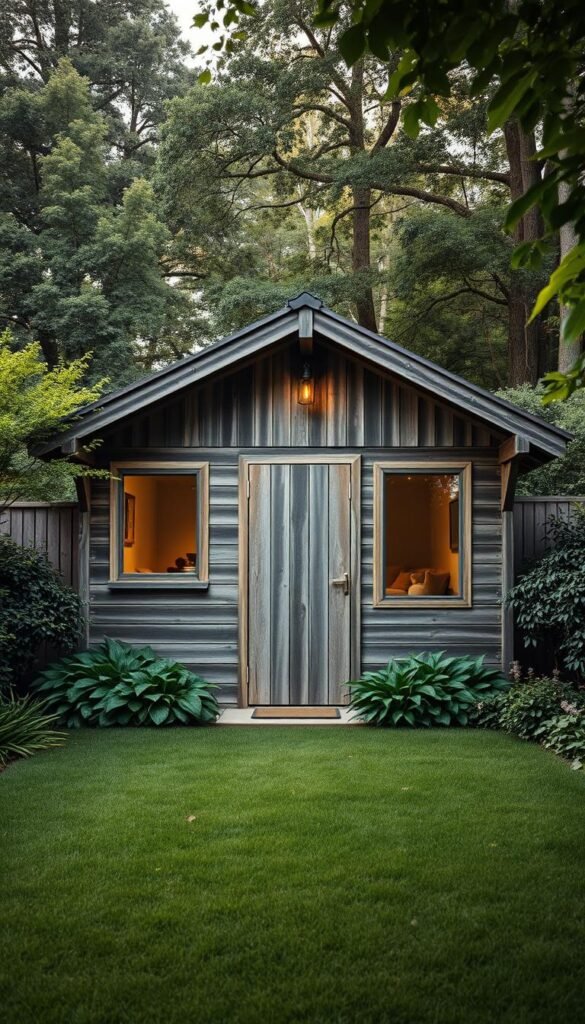
Combining historical charm with today’s tech makes structures that feel nostalgic yet function flawlessly. These hybrid creations trick the eye with weathered wood siding and antique hinges while hiding solar-ready roofs and smart storage systems inside. The result? Spaces that honor craftsmanship traditions while meeting 21st-century needs.
Start by selecting materials that age gracefully. Fiber-cement shingles mimic hand-split cedar but resist rot. For hardware, designers recommend cast iron latches paired with magnetic catches for smooth operation. This mix maintains vintage appeal while ensuring doors stay secure during storms.
| Element | Traditional Touch | Modern Upgrade |
|---|---|---|
| Walls | Reclaimed barn wood | Moisture-resistant backing |
| Lighting | Lantern-style fixtures | LED bulbs + motion sensors |
| Flooring | Distressed pine planks | Epoxy-coated durability |
Color palettes bridge eras beautifully. Try sage green trim with charcoal roofing – a combo found in both 1800s farmsteads and contemporary homes. For seamless integration, match your main house’s architectural lines while adding subtle updates like larger windows for better light flow.
Want more inspiration? Explore how vintage-modern hybrids create cohesive outdoor spaces. Remember: successful blends balance authenticity with innovation. Your structure should whisper history through its details while shouting modern convenience in every practical feature.
Enhancing Natural Light and Window Features in Sheds
Maximizing natural light isn’t just about aesthetics—it’s about creating a functional environment where every task feels effortless. Clever window placement balances brightness with privacy, especially when positioned above eye level. This approach floods your shed with sunshine while keeping tools or hobbies hidden from view.
- Double-hung windows: Perfect for ventilation control during potting projects
- Fixed glass panels: Maximize light in art studios without compromising wall space
- Skylights: Transform flat roofs into daylight channels
Greenhouse-style roofing takes illumination further. Polycarbonate panels create a diffused glow that nurtures seedlings without scorching them. One gardener reports: “My herbs thrive year-round under this setup—it’s like having a sunroom for plants.”
Energy efficiency matters in four-season climates. Look for double-paned glass with low-E coatings. These cut glare and heat loss while maintaining 90% light transmission. For security, choose laminated glass in ground-level windows and add simple slide locks.
Don’t forget airflow. Position operable windows across from each other to create cross-breezes that deter mold. In your garden shed, this circulation keeps the air fresh during long potting sessions while helping stains dry faster on brushes.
Lastly, let natural light amplify your structure’s personality. Arched frames soften angular builds, while grid patterns echo traditional home designs. Your space becomes brighter, safer, and infinitely more inviting—one well-placed pane at a time.
Maximizing Storage Space with Thoughtful Internal Layouts
Smart organization turns cramped areas into efficient hubs. By rethinking vertical surfaces and hidden zones, even compact structures become powerhouse storage spaces. The secret lies in layering solutions that adapt as your needs evolve.
Creative Shelving and Multi-Purpose Storage Ideas
Start by claiming every inch of airspace. Wall-mounted shelves with adjustable heights accommodate seasonal items – think holiday decor above and seed trays below. One homeowner transformed their 8×10 structure by adding ceiling racks: “I store kayaks overhead and still have room for my workbench below.”
These strategies keep tools accessible yet tidy:
- Magnetic strips for metal implements
- Pegboards with custom-shaped hooks
- Sliding drawers under work surfaces
Fold-down tables double as potting stations and project desks. When closed, they create clear pathways. For visibility, use clear bins labeled with paint markers. A Scandinavian-inspired design proves white interiors with large windows make finding items effortless.
Zone your space by frequency of use. Daily gloves and pruners go near the door, while seasonal gear tucks into high corners. Rotate stock like a retail display – front-facing baskets let you grab supplies fast. With these ideas, your structure becomes a model of efficiency where everything has its place.
Embracing Eco-Friendly and Green She
Building greener spaces starts with mindful choices that benefit both your yard and the planet. Eco-friendly structures reduce environmental impact while creating habitats for pollinators. Explore how native plant choices and permeable surfaces create low-impact landscapes that thrive with minimal upkeep.
Incorporate rainwater collection systems into your design. Pair them with drought-resistant species that need less watering. Solar-powered lighting along pathways cuts energy use, while reclaimed materials add character without new resource consumption.
Your choices extend beyond construction. Discover water-wise container gardening methods that prevent waste. Use porous planters and compost-rich soil to nurture roots naturally. Even small changes – like installing birdhouses or butterfly-friendly flowers – boost local ecosystems.
Every sustainable feature becomes part of your property’s story. From energy-efficient windows to recycled insulation, these decisions shape spaces that feel good to use and kinder to maintain. Your retreat doesn’t just serve you – it honors the environment that makes it possible.

